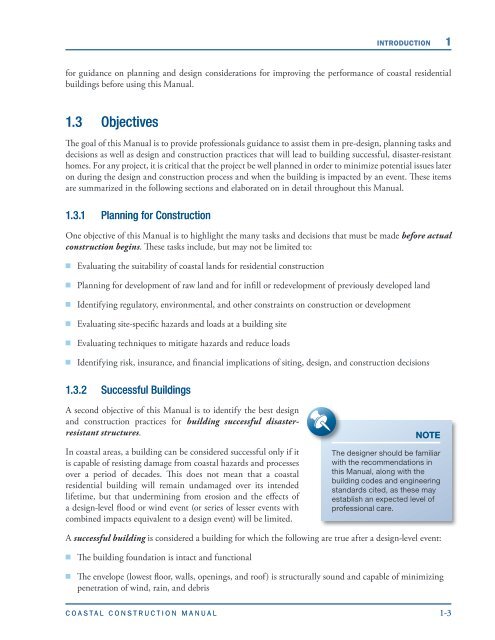Coastal Construction Manual - National Ready Mixed Concrete ...
Coastal Construction Manual - National Ready Mixed Concrete ...
Coastal Construction Manual - National Ready Mixed Concrete ...
You also want an ePaper? Increase the reach of your titles
YUMPU automatically turns print PDFs into web optimized ePapers that Google loves.
INTRODUCTION 1<br />
for guidance on planning and design considerations for improving the performance of coastal residential<br />
buildings before using this <strong>Manual</strong>.<br />
1.3 Objectives<br />
The goal of this <strong>Manual</strong> is to provide professionals guidance to assist them in pre-design, planning tasks and<br />
decisions as well as design and construction practices that will lead to building successful, disaster-resistant<br />
homes. For any project, it is critical that the project be well planned in order to minimize potential issues later<br />
on during the design and construction process and when the building is impacted by an event. These items<br />
are summarized in the following sections and elaborated on in detail throughout this <strong>Manual</strong>.<br />
1.3.1 Planning for <strong>Construction</strong><br />
One objective of this <strong>Manual</strong> is to highlight the many tasks and decisions that must be made before actual<br />
construction begins. These tasks include, but may not be limited to:<br />
<br />
Evaluating the suitability of coastal lands for residential construction<br />
<br />
Planning for development of raw land and for infill or redevelopment of previously developed land<br />
<br />
Identifying regulatory, environmental, and other constraints on construction or development<br />
<br />
Evaluating site-specific hazards and loads at a building site<br />
<br />
Evaluating techniques to mitigate hazards and reduce loads<br />
<br />
Identifying risk, insurance, and financial implications of siting, design, and construction decisions<br />
1.3.2 Successful Buildings<br />
A second objective of this <strong>Manual</strong> is to identify the best design<br />
and construction practices for building successful disasterresistant<br />
structures.<br />
In coastal areas, a building can be considered successful only if it<br />
is capable of resisting damage from coastal hazards and processes<br />
over a period of decades. This does not mean that a coastal<br />
residential building will remain undamaged over its intended<br />
lifetime, but that undermining from erosion and the effects of<br />
a design-level flood or wind event (or series of lesser events with<br />
combined impacts equivalent to a design event) will be limited.<br />
NOTE<br />
The designer should be familiar<br />
with the recommendations in<br />
this <strong>Manual</strong>, along with the<br />
building codes and engineering<br />
standards cited, as these may<br />
establish an expected level of<br />
professional care.<br />
A successful building is considered a building for which the following are true after a design-level event:<br />
<br />
The building foundation is intact and functional<br />
<br />
The envelope (lowest floor, walls, openings, and roof) is structurally sound and capable of minimizing<br />
penetration of wind, rain, and debris<br />
COASTAL CONSTRUCTION MANUAL<br />
1-3







